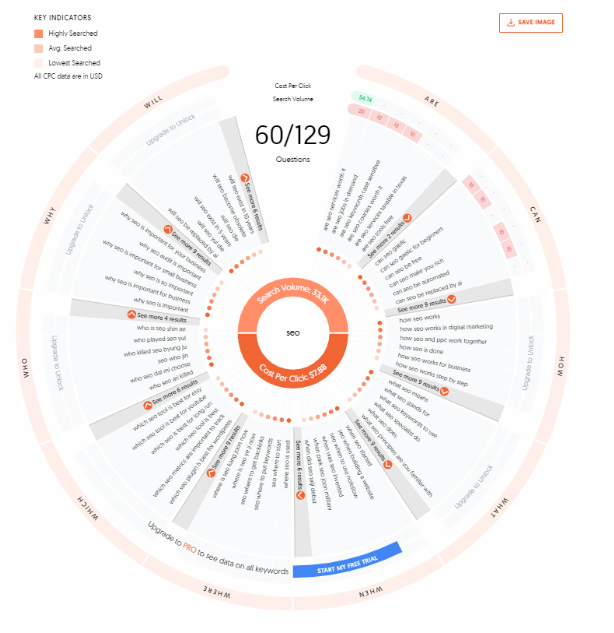
How to do a content audit
If you’re unsure of where to start, we’ve produced this easy-to-follow step-by-step guide so you can perform your own content audit. Keep reading to find a list of recommended tools and how you can use them too.
Steps for performing a content audit
Step 1: Define your goals
The first thing to do is consider what you want to achieve with your website content. Increased traffic? Boosted brand awareness? More leads or sales? Having clear goals will guide your audit and help you prioritise your findings.
Step 2: Gather your content
Make a list of all your website content, including blog posts, articles, landing pages, product descriptions and even infographics. Use your Content Management System (CMS) or website builder to generate a report or crawl your site with a dedicated tool. This will gather all your URLs automatically so you don’t have to manually track them all. Screaming Frog will allow you to do some of this for free, though larger sites may need a licence to crawl the whole thing.
Step 3: Organise your inventory
Create a spreadsheet to track your content. Include details like URL, content type (blog post, page, etc.), title, date published, author, and relevant keywords. This will be your central hub for analysis.
Step 4: Analyse the content’s performance
Pull data from your website analytics to see how each piece of content is performing. Look at metrics like page views, bounce rate, average time on page and conversions to identify high and low performers.
Step 5: Evaluate the content relevance
Is your content aligned with your current business goals and target audience? Review each piece for outdated information, irrelevant topics or content that doesn’t reflect your brand.
Step 6: Assess the site’s SEO
Check for technical SEO issues like broken links, missing meta descriptions or inadequate keyword usage. There are free and paid SEO audit tools available online to assist you with this step.
Step 7: Identify content gaps
Are there areas where your website lacks content to address user needs or compete with industry trends? Use your findings to brainstorm new content ideas that fill these gaps.
Step 8: Review content health
Look for broken elements, outdated information or formatting inconsistencies that detract from the user experience. This includes checking images and videos, and ensuring mobile-friendliness.
Step 9: Categorise and prioritise
Based on your analysis, categorise your content into different groups. This could be “keep and optimise”, “update”, “consolidate”, or “remove”. Prioritise your actions based on your goals and website traffic.
Step 10: Develop an action plan
Create a clear plan for taking action on your audit findings. This might involve updating content, optimising for search engines, scheduling content removal or creating new content. Set deadlines and assign tasks to ensure your audit translates into real website improvements.
By following these steps, you can conduct a comprehensive content audit and gain valuable insights into the health and effectiveness of your website content. Remember, a content audit is an ongoing process. Regularly revisit your findings and update your strategy to keep your website thriving in the digital world.
What tools can you use for a content audit?
It would be almost impossible to perform a content audit without the use of tools and apps that could help you. Below, you can find some of the most important and useful tools you’ll need when doing an audit of your website’s content.
Tools for content inventory and analysis:
Google Analytics & Search Console: These free tools from Google provide website traffic data, user engagement metrics, and basic SEO insights. They’re a great starting point to understand content performance.
Website crawlers: Tools like Screaming Frog can crawl your entire website and generate a report on all your content URLs, broken links and on-page SEO issues.

Tools for content optimisation:
SEO audit tools: Ahrefs, SEMrush and Moz offer advanced SEO features that can analyse your content for keyword usage, meta descriptions, and technical SEO best practices. If you’ve never used these before, their websites have lots of guides that explain how to best use the tools and excellent YouTube accounts with demonstrations, step-by-step videos, and more.
Grammarly & Hemingway Editor: These tools help with grammar, readability, and content clarity – crucial for improving user experience.


Tools for content planning and brainstorming:
Mind mapping tools: MindMeister or Miro can help you visually brainstorm content ideas, identify content gaps and organise your content strategy.
Answer the Public: Simply put in your keyword or content topic and in a couple of minutes, you’ll be provided with tons of new content ideas in an easy to read format.


Remember: The best toolset depends on your specific needs and budget. Start with free options like Google Analytics and a spreadsheet, and consider paid tools as your content audit becomes more sophisticated.




